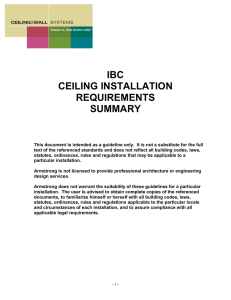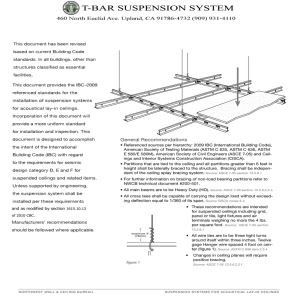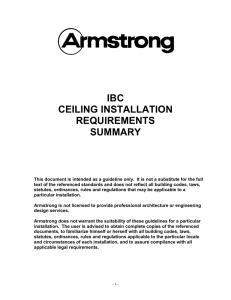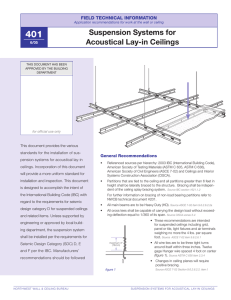Appendix B6 - City of Bellevue
advertisement
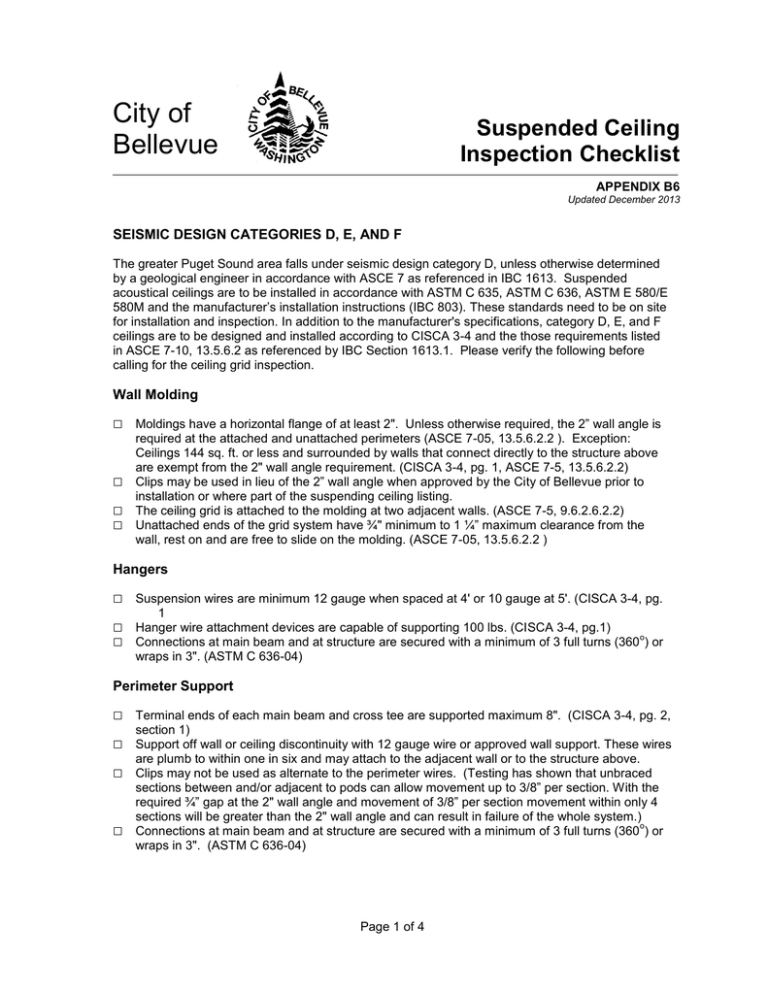
City of Bellevue Suspended Ceiling Inspection Checklist APPENDIX B6 Updated December 2013 SEISMIC DESIGN CATEGORIES D, E, AND F The greater Puget Sound area falls under seismic design category D, unless otherwise determined by a geological engineer in accordance with ASCE 7 as referenced in IBC 1613. Suspended acoustical ceilings are to be installed in accordance with ASTM C 635, ASTM C 636, ASTM E 580/E 580M and the manufacturer’s installation instructions (IBC 803). These standards need to be on site for installation and inspection. In addition to the manufacturer's specifications, category D, E, and F ceilings are to be designed and installed according to CISCA 3-4 and the those requirements listed in ASCE 7-10, 13.5.6.2 as referenced by IBC Section 1613.1. Please verify the following before calling for the ceiling grid inspection. Wall Molding Moldings have a horizontal flange of at least 2". Unless otherwise required, the 2” wall angle is required at the attached and unattached perimeters (ASCE 7-05, 13.5.6.2.2 ). Exception: Ceilings 144 sq. ft. or less and surrounded by walls that connect directly to the structure above are exempt from the 2" wall angle requirement. (CISCA 3-4, pg. 1, ASCE 7-5, 13.5.6.2.2) Clips may be used in lieu of the 2” wall angle when approved by the City of Bellevue prior to installation or where part of the suspending ceiling listing. The ceiling grid is attached to the molding at two adjacent walls. (ASCE 7-5, 9.6.2.6.2.2) Unattached ends of the grid system have ¾" minimum to 1 ¼” maximum clearance from the wall, rest on and are free to slide on the molding. (ASCE 7-05, 13.5.6.2.2 ) Hangers Suspension wires are minimum 12 gauge when spaced at 4' or 10 gauge at 5'. (CISCA 3-4, pg. 1 Hanger wire attachment devices are capable of supporting 100 lbs. (CISCA 3-4, pg.1) o Connections at main beam and at structure are secured with a minimum of 3 full turns (360 ) or wraps in 3". (ASTM C 636-04) Perimeter Support Terminal ends of each main beam and cross tee are supported maximum 8". (CISCA 3-4, pg. 2, section 1) Support off wall or ceiling discontinuity with 12 gauge wire or approved wall support. These wires are plumb to within one in six and may attach to the adjacent wall or to the structure above. Clips may not be used as alternate to the perimeter wires. (Testing has shown that unbraced sections between and/or adjacent to pods can allow movement up to 3/8” per section. With the required ¾” gap at the 2" wall angle and movement of 3/8” per section movement within only 4 sections will be greater than the 2" wall angle and can result in failure of the whole system.) o Connections at main beam and at structure are secured with a minimum of 3 full turns (360 ) or wraps in 3". (ASTM C 636-04) Page 1 of 4 Perimeter Spacers Ends of main runners and cross tees are tied together (spreader bars or equivalent) to prevent spreading. (CISCA 3-4, pg 2 section 1, #4) Clips may be used in lieu of spreader bars when approved by the City of Bellevue prior to installation. Suspended Ceiling System General note: ASTM C636, CISCA and manufacturer determine the duty classification of a grid system by the load carrying capacity of the main runners. Evaluation reports for manufacturer's system are onsite and available for the installer and the inspector. (Contact ICC Evaluation Services, http://www.icc-es.org/Evaluation_Reports/) Main beams are heavy duty (ASCE 7-05, 13.5.6.2.2 Main beam and cross tee intersections and splices have connection strengths of a minimum 180 lbs. in compression and in tension. (CISCA 3-4, pg 1 section 3, #2) Cross tees supporting light fixtures have the same load carrying capacity as the main beams or are installed with supplemental hangers within 3" of each corner of each fixture. (CISCA 3-4, pg 2, section 2) (See also Light Fixtures portion of this checklist) Cross tees supporting mechanical services have the same load carrying capacity as the main beam or are installed with supplemental hangers within 3" of each corner of each fixture*. (CISCA 3-4, pg 2, section 3) (See also Mechanical Services in this checklist.) *The City of Bellevue has determined that it is acceptable practice to apply the same supplemental wire application, as is allowed for light fixtures, to mechanical services in addition to the requirements in the Mechanical Services portion of this checklist. Lateral Force Bracing Ceilings constructed of lath and plaster or screw-applied gypsum board attached to suspended members designed for this use, which are on one level and extend from wall to wall, are exempt from lateral load design requirements. (CISCA 3-4, pg. 1, exception #1) Ceiling areas greater than 1000 sq. ft. have lateral force bracing. Rigid bracing may be used instead of diagonal splay wires. (IBC 1613.1, ASCE 7-5, 13.5.6.2.2) Bracing must limit ceiling movement to less than ¼" at the point of attachment. (IBC 1613.1, ASCE 7-05, 13.5.6.2.2) Splay wire bracing is in clusters of four 12 gauge wires attached to the main beam within 2" of the cross tee intersection. Wires are arrayed 90º from each other at an angle not exceeding 45º from the plane of the ceiling. (CISCA 3-4 pg 2, section 1, #3) A strut, with stiffness adequate to resist the vertical loads imposed, is attached to the suspension system and to the structure above at each bracing location (CISCA 3-4 pg 2, sec 1, #3). Install struts specified by manufacturer for proprietary systems or select an approved strut from Table 1 or provide an engineered strut. Attach strut to grid with minimum (2) #8 self drilling, self tapping steel screws and to structure with (2) #6 wood screws, single shot pin or (2) #8 self drilling, self tapping steel screws per construction conditions. (Doesn’t apply to conduit type struts.) Horizontal restraint points are no more than 12' on center in each direction, and the first point must be within 6' of each wall unless otherwise required. (CISCA 3-4, pg 2, sect. 1, #3) Attachment of the bracing wires to the main beam and to the structure are capable of supporting the greater of 200 lbs or the actual design loads with a safety factor of 2. (CISCA 3-4, pg 2, sec 1, #3) Bracing members are spaced a minimum of 6" from all horizontal piping or duct work that is not provided with bracing restraints for horizontal forces. (CISCA 3-4, pg 2, sec 1, #3) Page 2 of 4 Light fixtures All fixtures are positively attached to the suspension system. The attachment device is able to withstand 100% of the weight of the fixture acting in any direction. (CISCA 3-4 pg 2, sect. 2) Cross runners supporting the ends of lighting have the same carrying capacity (16lb./Ft.) as the main tees or require supplemental No. 12 gauge hanger wires attached to the grid members within 3 “ of each corner of each fixture supported by a cross tee. (CISCA 3-4 pg 2, sect. 1 & 2) Fixtures weighing 56 lbs. or less have two 12 gauge wires attached at diagonal corners. These wires may be slack. (CISCA 3-4 pg 2, sect. 2) Fixtures weighing in excess of 56 lbs. are independently supported from the building structure. (CISCA 3-4 pg 2, sect. 2) Pendant mounted fixtures are supported directly from the structure using 9 gauge wires. They may not use the ceiling suspension system for support. (CISCA 3-4 pg 2, sect. 2) Mechanical Services Mechanical services less than 20 lbs. are positively attached to the suspension system main beams or to cross tees with the same load carrying capacity. (CISCA 3-4, pg. 2, section 3) City of Bellevue option: Where cross runners don’t have the same carrying capacity as the main tees, attach supplemental No. 12 gauge hanger wires to the grid members within 3 “ of each corner of each fixture supported by a cross tee. Terminals or services weighing 20 lbs. to 56 lbs. have two 12 gauge wires connecting them to the ceiling system hangers or to the structure above. (CISCA 3-4, pg. 2, section 3) Terminals or services weighing more than 56 lbs. are independently supported. (CISCA 3-4, pg. 2, section 3) See “Working clearances and removable tees” at the end of Appendix B6 Partition Attachment Partitions attached to the ceiling suspension system are laterally braced to the building structure. This bracing is independent of any ceilings splay wire bracing. (IBC 1613.1, ASCE 7-5, 13.5.6.2.2) Attached partitions cannot cross seismic separation joints. Penetrations Ceilings without rigid bracing have 2" oversized trim rings to allow 1" horizontal movement in all horizontal directions at sprinkler heads and other penetrations. Alternatively, a swing joint that can accommodate 1" of ceiling movement in all horizontal directions at the top of the sprinkler head extension. (IBC 1613.1, ASCE 7-05, 13.5.6.2.2) Seismic Separation Joints Ceiling areas greater than 2500 sq.ft.have seismic separation joints or full height partitions unless analyses are performed to demonstrate that the closure trims and angles provide enough clearance to accommodate the additional ceiling movement. Each area to provide ¾" clearance as detailed above under Wall Molding. Refer to manufacturer for seismic separation joint or provide alternate system to the city for review. (IBC 1613.1, ASCE 7-05, 13.5.6.2.2) Unless specifically exempted by the system, lateral force bracing would be required within 6ft. of the joint as if it was a stand-alone ceiling. Unless specifically exempted by the system, perimeter wires and/or hanger wires would be required at each side of the seismic separation joint as if it was a stand-alone ceiling. Maintain connection of grid to (2) adjacent walls as noted under the Wall Molding section. Where multiple seismic separation joints create a condition where a wall connection is not possible, lateral force bracing or equivalent will be provided to satisfy the adjacent wall requirement. Perimeter spacers (spreader bars) or equivalent are installed at either side of joint. Exception: When seismic expansion clips or other preapproved equivalent is used. Page 3 of 4 Height Transitions Changes in ceiling plane elevation have positive bracing. (IBC 1613.1, ASCE 7-05, 13.5.6.2.2) Cable Trays Cable trays and electrical conduits are independently supported and braced independently of the ceiling. (IBC 1613.1, ASCE 7-05, 13.5.6.2.2) Coordinate with electrical and mechanical inspectors and contractors for location and clearance requirements for electrical equipment and disconnects. Working Clearances and Removable Tees Removable cross runners may be used to provide working clearances for electrical equipment and disconnects as required by the City’s Electrical Code. Removable cross runners shall have the locking tabs removed If a removable section of main runner is needed, a seismic restraint pod will be required on the fixed main runner within 6 feet of the break on each side of the removable section. The compression strut shall be braced with a rigid member not less than 1- 2-1/2” 25 gauge. stud for each axis (2 rigid braces as opposed to 4 splay wires). Each rigid brace shall not be greater than 45 degrees from horizontal. Rigid braces for pods longer than 120 inches require engineering. Each removable main runner section shall be connected to a support wire within 8 inches of each end and not more than 48 inches apart. No more than one such main runner opening will be allowed in each pod zone (144 sq. ft.). Each removable tee shall be permanently marked so as to be readily identifiable from below. City of Bellevue Approved Struts TABLE 1 MAXIMUM COMPRESSION STRUT LENGTHS FOR 180 LB. SEISMIC LOAD MEMBER SIZE MAXIMUM LENGTH Single 1-5/8” metal stud (20 gauge) 10 feet Back-to-Back 1-5/8” metal studs (20 gauge) 15 feet Single 2-1/2” metal studs (20 gauge) Back-to-Back 2-1/2” metal studs (25 gauge) Engineering is required for braces longer than 10 feet, or compression struts longer than 15 feet or alternate material not shown. Engineering shall include the maximum height, type of material, and the connection to the grid and structure above. Page 4 of 4 13.5 feet 15 feet
